2014 Set Top Box White Paper
In 2014, China's national digitalization is about 60%
China's radio and television and audio-visual entertainment industries are in a period of diversification and rapid development. The competition between cable, terrestrial, satellite, IPTV, and the Internet is even fiercer. Users can have more choices.
According to Gran Data, as of September 2014, China has nearly 280 million digital set-top boxes, and the popularity of digital set-top boxes has reached nearly 70%. The digitization of the entire population has reached nearly 60%, and China’s overall digitalization has achieved results. Gran research and analysis believes that China's overall digitalization is getting higher and higher. Based on the more matured development and application of TV screens in the industrial environment, more people-friendly applications will be developed to meet the diverse needs of users in order to increase users' TV screens. The stickiness.
China's digitization process
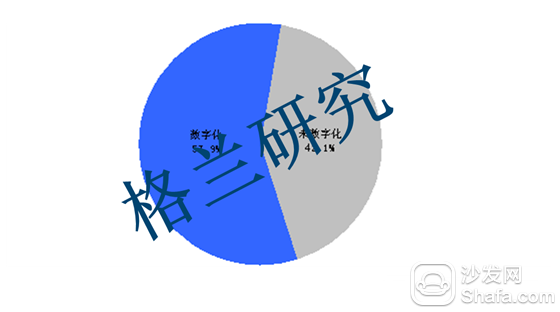
China's digital set-top box users are still mainly watching programs through cable set-top boxes. With the overall cable digital transformation in full swing across the country, Gran Data shows that as of September 2014, cable digital users accounted for nearly 70% of the total. Other users mainly watch TV programs via live satellite set-top boxes, IPTV, and OTT TVs. The users of terrestrial digital set-top boxes are relatively small. The impact of IPTV and OTT TV set-top boxes on cable set-top boxes has gradually increased, and the satellite “black pot†is also hitting the rural market of cable set-top boxes; the cable set-top box market is in full swing, prompting cable operators to introduce more coping strategies such as “wired + wirelessâ€. "Integrated development" and "speeding up the promotion of intelligent set-top boxes" will bring new blood to the cable set-top box market and increase future market vitality; otherwise, the cable set-top box market will gradually be eaten up.
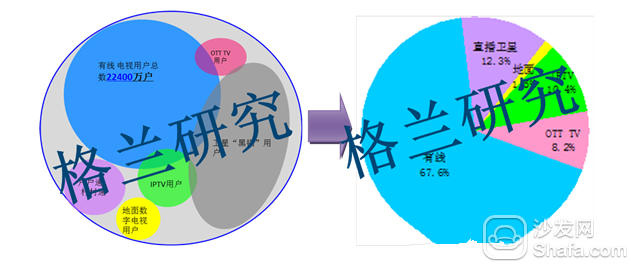
According to Gran Data, as of the end of September 2014, China’s set-top box market exceeded 320 million units, an increase of more than 44 million from the end of 2013, with an increase of 15.7%.
Gran research and analysis believes that China's set-top box market is still in a boom cycle, maintaining a high growth rate; the cable and satellite set-top box market continues to grow steadily; affected by the macroeconomic policies of the SARFT, the Internet set-top box market entered a wait-and-see period in the second half of 2014 During the adjustment period, the market has shrunk dramatically, but its shipments are only lower than that of cable, and the market activity is still high.
From September 2009 to September 2014, China's set-top box population market developed.

With the development of terminal Internet, the types of set-top boxes are diversified. With the base number of 430 million households in China, Gran Data shows that there are 75 sets of STBs per 100 users in China, compared to 2013 (65). (Taiwan), 10 sets have been upgraded, and the ownership of set-top boxes has been continuously improved; and with the more diverse set-top box support functions, the range of users' choices is even greater, and the proportion of set-top boxes per 100 households will continue to increase, such as education and games. The box for sales highlights is more attractive to some user groups because of its professionalism, exclusivity, etc. The user's home set-top box is no longer just for watching programs, but is given more roles.
OTT TV set-top box new market share second only to cable
OTT TV set-top box market status is improved, second only to cable set-top boxes.
According to data from Gran, from January to September 2014, the OTT TV set-top box market accounted for 30% of the new set-top box market. Compared with 2013 (18.4%), the market share increased by 11% and the market position has been significantly improved. As a result, IPTV and satellite set-top boxes dropped significantly in the newly added market, and cable set-top boxes did not drop significantly in the new markets, and still dominated the new market.
2013 and 2014 China's share of different types of set-top box market share
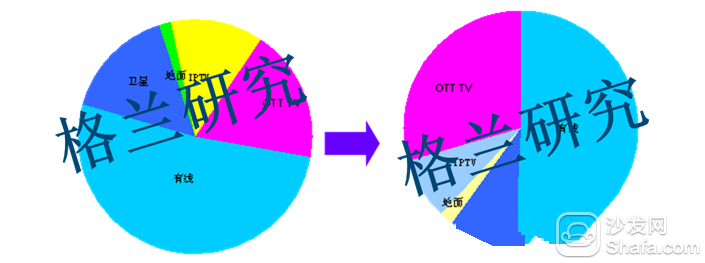
Gran research and analysis believes that under the inevitable trend of industrial convergence, the competition faced by broadcasting and television is also intensifying. The Internet has infiltrated our lives in every aspect. Based on the Internetization of end users, many interactive work and interconnection work require set-top boxes to complete. Set-top box products will not be replaced, but will diversify into products: Set-top box products serving the operator market must be upgraded, product form to the high-end development; traditional set-top box companies in the operational thinking will have a subversion and rebirth process, set-top box The market competition will also be more intense.
Wired set-top box inventory market to standardize the business development
The cable SDTV set-top box has a stock of more than 180 million units and is mainly one-way, providing a good opportunity for future product update iterations. According to Gran Data, as of the end of September 2014, the cable set-top box market had a cumulative shipment volume of 221.856 million units, of which the cable SDTV set-top box market reached over 180 million units, which accounted for about 81.6% of the line set-top box, although with the HD set-top box. The volume of shipments has gradually increased and the market share of cable standard set-top boxes has gradually declined. However, the market stock is still large, and the list is mainly oriented. For the business development, these low-end standard-definition set-top boxes cannot effectively support the development of new services and are becoming a stumbling block for the development of wired network services. They have been affected by OTT TV and IPTV, and some markets have been replaced; but for the entire set-top box industry, These low-end set-top boxes also provide market opportunities for product upgrades and provide more business opportunities for high-definition interactive set-top boxes.
September 2012-2014 Schematic diagram of the sales volume of high-standard SDTVs in STBs
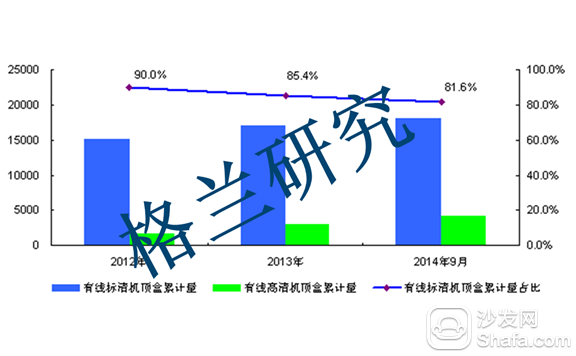
Wired set-top boxes new shipments HD higher than standard definition
According to data from Glenn Research, in 2014, shipments of cable HD set-top boxes were significantly higher than standard definition, and shipments of HD set-top boxes accounted for 52% of the newly added market. Compared to 2013 (39.1%), the share of high-definition set-top boxes increased. 12.9%, demand for cable high-definition set-top box market grows rapidly. In order to enhance competitiveness, cable operators directly use high-definition set-top boxes for full-scale conversion, such as Henan, Shandong and other regions; Some operators increase marketing promotion to promote popular high-definition set-top boxes, such as Tianjin Pre-stored viewing fees will receive free HD set-top boxes.
China's cable set-top boxes in 2014 and 2013 accounted for the high standard-definition shipments.

Cable set-top box market is relatively stable
According to data from Glenn Research, from January to September 2014, China’s cable set-top box market shipped over 22 million units, and Skyworth’s cable set-top box shipments remained the No. 1 market, with a market share of 13.3%, and Jiuzhou ranked second, the Galaxy. Ranked third, Nine United ranked fourth, Cisco ranked fifth, Inspur ranked sixth, Changhong ranked seventh, with Chau, Hisense tied for eighth.
January-September 2014 Wired STB Manufacturers Market Shipments

Total HD set-top box market exceeds 75 million units
According to Gran Data, as of September 2014, the cumulative shipments of HD set-top boxes in China exceeded 75 million units, of which, from January to September 2014, the total number of HD set-top boxes increased by 26.777 million units, accounting for 60.0 of the new set-top box market. %. Gran research analysis believes that the rapid growth of high-definition set-top boxes is mainly due to:
All regions have increased efforts to promote HD set-top box services, and most operators have already completed digitization. New cable users directly use high-definition set-top boxes to perform full rotations, and cable operators increase their efforts to promote HD set-top boxes.
Although OTT TV set-top boxes were affected by national controls in the second half of 2014, shipments slowed down, but new shipments continued to exceed 13 million units in January-September 2014; telecom operators also increased their coverage of OTT TV set-top boxes. Promotion, bundled high-bandwidth services to give OTT TV set-top boxes.
China's High-Definition Set-Top Box Development in September 2009-2014
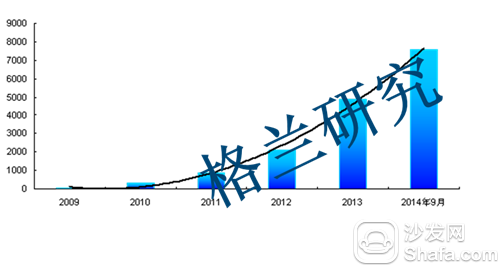
OTT TV set-top box is the main force in the new market of high-definition set-top box
Gran Data shows that from January to September 2014, OTT TV set-top boxes accounted for 48.9% of the new HD set-top boxes, and the market share increased by 8.4 percentage points compared to 2013 (40.5%); Wired HD set-top boxes added to the market The proportion is lower than OTT TV set-top box for the first time; the proportion of IPTV high-definition set-top box market drops significantly, mainly because telecom operators will put more effort into the promotion and development of OTT TV. Gran Research expects that the growth of the HD set-top box market will be dominated by cable HDTVs and OTT TV set-top boxes in the short term.
Comparison of High-Definition Set-top Box Market Structure in 2013 and January-September 2014
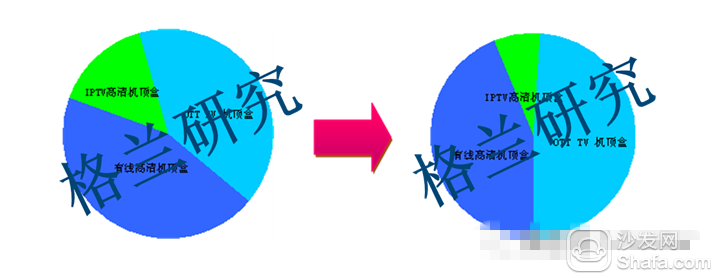
Shipments of HD set-top boxes are steadily rising. Intelligent development is a trend
According to Gran Data, as of the end of September 2014, the cable HD set-top box market had more than 40 million units, accounting for 18.4% of the total market for the set-top box; as Henan, Shandong, and other regions continued to promote “direct high-definition conversion†or “High-Definition Secondary Conversion†and the promotion of high-definition interactive services in Guizhou, Tianjin, Guangxi, Shaanxi, Guangdong, Sichuan and other regions will continue to maintain steady growth in cable HD set-top box shipments.
China's cable HD set-top box development in September 2009-2014
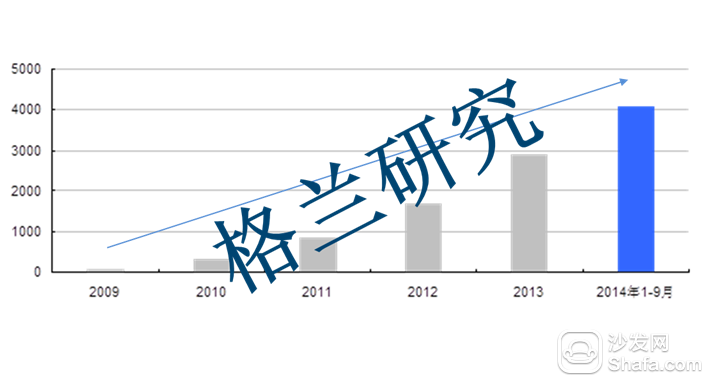
Gran research and analysis believes that in 2014, cable operators increased their attention and investment in smart set-top boxes/home gateways. In some regions, wired intelligent set-top boxes have begun to be promoted and applied, and they have occupied the market for the next phase of business development. Wireline operations can expand the coverage of existing video services through the development of smart set-top boxes/home gateways, and can provide support for personalized services (video calls, smart homes), combined with the construction of Radio and TV IDC Intranet resources to provide users with high-quality video and personality. Business Wireline + Broadband "through-train service" to enhance its competitiveness; through the combination of wired and wireless development, the expansion of cable TV services will expand from TVs to smartphones, PADs, laptops and other terminals, enabling users to be within wireless coverage areas. Through a variety of terminals to enjoy television services, to enhance the freedom of use; thus reaching the user, fostering user dependence, reducing the user off the Internet.
Overall slowdown in the IPTV market Growth in individual regions
According to data from Glenn Research, from January to September 2014, the shipment of IPTV set-top boxes was significantly lower than that of 2013, and the overall IPTV development is slowing down. However, the IPTV set-top boxes in certain regions have been significantly accelerated, such as Sichuan and Hebei Provinces. In the region, the impact on the local cable set-top box market will be greatly affected; and IPTV will also gradually infiltrate into rural areas, which will further affect the market promotion of cable set-top boxes in rural areas, and it will be more easily accepted by users through bundled broadband.
China's IPTV set-top box development in September 2010-2014
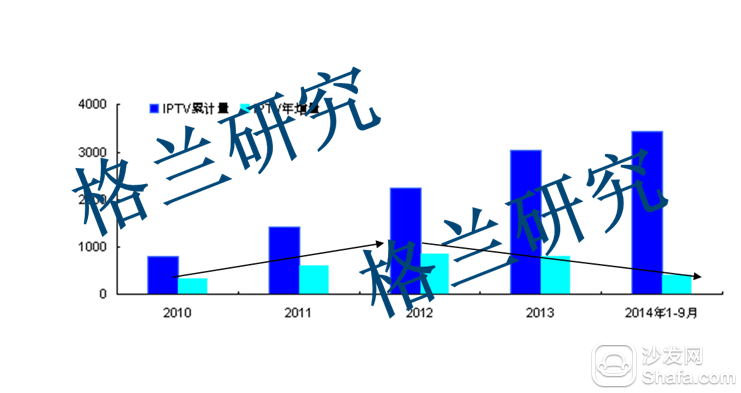
The satellite set-top box market has gradually expanded
More than 38 million sets of direct-sale satellite set-top boxes were shipped, and the proportion of the “door-to-door†market gradually expanded.
According to data from Gran Research, as of September 2014, cumulative satellite set-top box shipments totaled more than 38 million units, including 40.1% of the "domestic-pass" direct-broadcast set-top boxes, compared to 2013 (35.6%). The proportion of direct-home satellite set-top boxes has gradually expanded, laying a foundation for future commercial use. As more areas promote the “domestic access†project of live satellites, and as the live satellite satellite set-top box gradually closes the clearing signal, the demand for direct-to-air satellite set-top boxes will further increase, but the market demand in the short term will be insignificant; with the commercialization of the direct broadcast satellite market The operation will further drive the development of the direct satellite set-top box market, and increase the ARPU of the user. However, how to choose a business that is suitable for rural areas is more easily accepted by rural users and will be a difficult point for commercial applications in the future.
Comparing the cumulative shipments of STBs from "Village Village" to "Household Link" from January to September 2012-2014
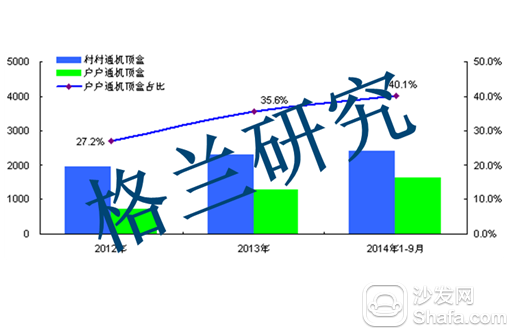
Intelligent set-top box development and trends
The definition of smart set-top box and the diversification of product form
The set-top boxes that set up the operating system can all be called intelligent set-top boxes. Currently, most of them are built android operating systems.
Gran research shows that currently the smart set-top box brands on the market mainly come from the following channels: Licensing companies own self-owned smart set-top boxes, such as Xiao Hong, launched through OEM; Internet companies or set-top box manufacturers rely on the content of licensees Resources launched its own brand of smart set-top boxes, such as millet; operators rely on the license provider's content resources to launch their own-brand smart set-top boxes, such as Yueme.
Before the third quarter of 2014, there were still a large number of smart set-top boxes (also called network set-top boxes or high-definition players) that could illegally aggregate network video resources and set-top boxes of network video companies' own brands.
If the function of smart set-top boxes in 2013 was similar to that of lack of innovation, since 2014, smart set-top box products have been continuously introduced in the tide of industrial convergence, and the concept itself has been continuously improved. The product types of smart set-top boxes that appear on the market today mainly include:
Network set-top box:
Network set-top box + game console
The network set-top box + router: Also called an intelligent router, it is typically characterized by an operating system and WIFI functions. The main functions are access to network video and wireless routing functions. According to Gran Research, smart routers are still in the start-up phase of the vendor education market. The typical feature is that the number of incoming vendors has gradually increased, and sales volume has been slowly increasing. The general public has begun to recognize commodities, and some technology enthusiasts have tried to use them one after another. Since June 2014, more than ten new products have been launched in succession. Smart routers are in hardware competitions including processors, memory, storage capabilities, signal coverage, and penetration capabilities.
Network STB + Gateway: Also called an intelligent gateway, the typical feature is that it has an operating system and interconnection capabilities. The main function is to allow multiple receiving devices to interconnect and accept commands through an intelligent gateway.
Network set-top box + multi-mode: The typical feature is an operating system and multi-mode demodulation function, multi-mode demodulation support receiving cable TV, Internet TV, terrestrial digital TV, etc. Such a set-top box on the market also supports multi-screen mutual conversion.
Network STB + Wearable Device
Gran research and analysis believe that the smart set-top box on the market is forming the trend of “video + X†from the product form. Smart set-top boxes can not only deliver video content, but also more in the future in professional services. These specialized areas can include services such as health, education, and community, as well as specific age groups such as the elderly and children. A trend has become more apparent.
Mango TV at the August 2014 Internet TV Terminal Symposium suggested that OTT set-top box manufacturers should increase investment in differentiated competition based on providing video services to users, and adopt the "video + X" model to develop services. In "video + games", "video + karaoke", "video + shopping", "video + smart home." In the box field, differentiate development from the different needs of users.
LeTV announced in September 2014 that it will cooperate with Hujiang.com, an online education platform, to jointly create educational box products. In November 2014, Le Xiaobao's products were released. In July, China Telecom initiated the establishment of the Smart Home Industry Alliance for the Elderly.
From crazy to intelligent smart set-top box market
The smart set-top box market in 2014 was like a roller coaster. In the first half of 2014, the speed of development reached a high point. Both the set-top box and chips, and even license holders and operators, were pursuing market and technology speeds.
The set-top box market license market is busy with enclosures, and the white card market is busy endorsing books.
The mainstream smart set-top-box chip companies in the chip market have all launched four-core products. Some chip companies have even launched eight-core products and the process has turned to 28nm.
On the carrier's market, Telecom, China Unicom, Mobile, Dr. Peng, and Broadcasting and Television are busy planning and deploying tasks, catching up with the hardware configuration of the retail market, and market innovations, constantly refreshing the market landscape.
The operating system android has a unified trend, but it can't stop the pace of the company's self-built platform. Some companies that have achieved success are eager to try, and the SARFT has begun to promote the TVOS operating system.
Video technology 4K, DRM, AVS+, H.265, and new highlights continue to create new profit points. Intelligent technology, human-computer interaction, human body recognition, voice search, private cloud technology, etc., the industry chain is unprecedentedly active.
In the second half of 2014, the market for intelligent set-top boxes was changed.
In the early to mid-2014, the smart set-top box market developed arbitrarily, and the application of APP non-compliant video applications directly led to the loss of control of EPG management of intelligent set-top boxes.
In the third quarter of 2014, SARFT continuously interviewed seven major licensees and reaffirmed Circular 181 to strengthen the control over the dissemination of Internet content. After a series of regulatory policies continued to ferment, illegal video aggregation software continued to destage from the TV application market, and regulatory policies The influence surfaced from the license plate market to the white card market, causing an overall decline in the shipment of the entire internet set-top box market.
Industry chain vendors have begun to redefine product boundaries, gradually returning to Internet TV platforms with licenses as their core, and the battle for the entrance of digital homes with intelligent set-top boxes as entrances has come to an end.
Smart STB Shipment in the First Three Quarters of 2014
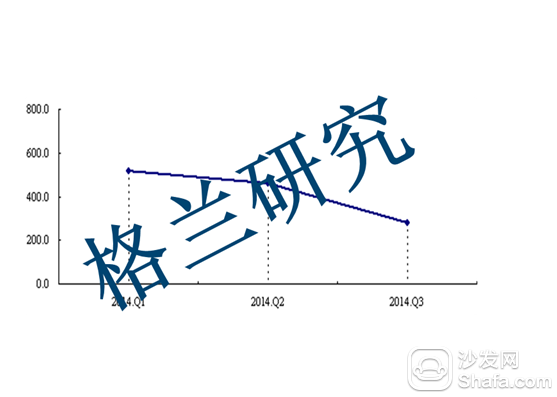
Gran research and analysis believe that the impact of macroeconomic policies of the SARFT, the smart set-top box market in the third quarter of 2014 into the wait-and-see period and adjustment period, the third quarter Internet set-top box market has shrunk dramatically, it is expected that this situation will continue to the fourth The quarter will affect the first half of 2015. The supervision of the Internet market by the General Directorate has become the norm. All aspects of the intelligent set-top box product chain will more clearly define its own industrial location and product boundaries. As more and more users need to access the Internet through powerful intelligent set-top boxes and high-speed mobile networks, Enjoy rich data services and Internet services. Smart set-top boxes after 2015 will gradually recover in the second half of the year. It is expected that the stock of smart set-top boxes will reach about 85 million units by the end of 2017. The B to C market is still the main market for smart set-top boxes. Dating makes up 60% of the total.
Gran research and analysis believes that although the smart set-top box underwent a process of development from madness to reasoning in 2014, the market diversification pattern that has experienced the baptism of smart set-top boxes has already taken shape. This diversified pattern can be divided into two major markets: operator market and retail market. Gran research and analysis believes that both the operator market and the retail market will influence each other. The retail market product market will have a significantly faster market than the operator market, which will affect the replacement rate of operators' market products, while the operators' market products will continue to change. It is hoped that the smart set-top box will eventually be launched into the retail market.
Smart set-top box market diversification pattern

Think of Smart Set Top Boxes
The use of smart set-top boxes for accurate advertising based on big data is becoming one of the key development goals for operators. However, data problems are still the major challenges for personalized services. According to the survey conducted by Expertian Data Quality in mid-2014, we learned quickly to understand and implement individuality. The biggest obstacle to the service is to obtain enough data and the accuracy of the data is still second, and the data problem depends on the further development of intelligent technologies such as human body recognition to further solve.
How deep does the smart set-top box affect the closed system of broadcasting and TV? The smart set-top box will become a fuse and igniter for a series of profound changes in the broadcasting and TV industry. From the micro level, the concept of video content extends from the content of television stations and video websites to TV applications, and promotes wide-area set-top boxes to find TV application resources. Form a bundle; promote the development of STBs from traditional middleware platforms to smart operating system platforms. As over 200 million traditional STBs have been accumulated in the past decade, these set-top boxes will be ready to be replaced during the conversion process; Set-top box product form diversification and speed up the update.
From a macro perspective, the broadcasting and TV industry will change from a relatively closed system to a relatively open one; the continuous convergence of television applications will eventually drive the industry toward platform-based operations; the continuous integration of traditional media and new media will eventually drive the industry toward the Internet.
For the manufacturers of wide-area STBs, a large number of Internet companies and new technology companies rushed into the set-top box industry. These companies are accustomed to the rhythm of consumer electronics, and promote the rapid development of the set-top box product form, while traditional radio and television operators have been engaged in the product form. The slow operator market, how to continue to maintain the leading position in the set-top box industry technology and market? Broadcasting system has many specialities, how to plan the path of the wide-Electrical top box intelligent? How can the business cooperation relationship between the wide-area set-top box manufacturers and television applications? In the process of platform operation, if you establish a platform for television applications?
For industry supervision:
The rapid development of television applications has produced TV application products, such as television education and video games, which have great development prospects. Because these applications are all subject to cross-jurisdiction of departments, the future management is defined.
The typical feature of an intelligent set-top box is that it has an operating system. Currently, the operating system has its own android. However, based on considerations such as security stability, the SARFT is making great efforts to promote TVOS. The situation?
The most important issue is that the industry as a whole needs a detailed reference path to development.
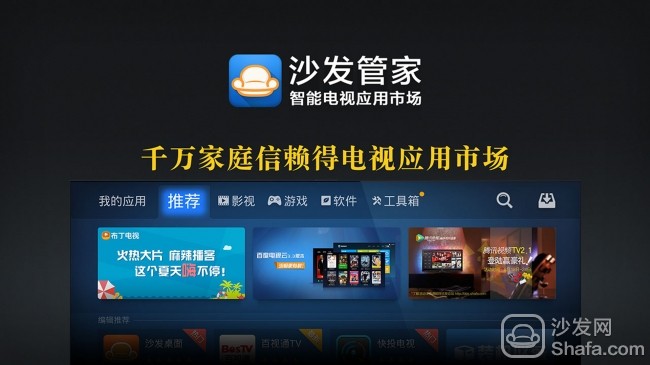
China's radio and television and audio-visual entertainment industries are in a period of diversification and rapid development. The competition between cable, terrestrial, satellite, IPTV, and the Internet is even fiercer. Users can have more choices.
According to Gran Data, as of September 2014, China has nearly 280 million digital set-top boxes, and the popularity of digital set-top boxes has reached nearly 70%. The digitization of the entire population has reached nearly 60%, and China’s overall digitalization has achieved results. Gran research and analysis believes that China's overall digitalization is getting higher and higher. Based on the more matured development and application of TV screens in the industrial environment, more people-friendly applications will be developed to meet the diverse needs of users in order to increase users' TV screens. The stickiness.
China's digitization process

China's digital set-top box users are still mainly watching programs through cable set-top boxes. With the overall cable digital transformation in full swing across the country, Gran Data shows that as of September 2014, cable digital users accounted for nearly 70% of the total. Other users mainly watch TV programs via live satellite set-top boxes, IPTV, and OTT TVs. The users of terrestrial digital set-top boxes are relatively small. The impact of IPTV and OTT TV set-top boxes on cable set-top boxes has gradually increased, and the satellite “black pot†is also hitting the rural market of cable set-top boxes; the cable set-top box market is in full swing, prompting cable operators to introduce more coping strategies such as “wired + wirelessâ€. "Integrated development" and "speeding up the promotion of intelligent set-top boxes" will bring new blood to the cable set-top box market and increase future market vitality; otherwise, the cable set-top box market will gradually be eaten up.

China’s total number of set-top boxes exceeded 320 million. The average number of set-top boxes per 100 households increased by 10
According to Gran Data, as of the end of September 2014, China’s set-top box market exceeded 320 million units, an increase of more than 44 million from the end of 2013, with an increase of 15.7%.
Gran research and analysis believes that China's set-top box market is still in a boom cycle, maintaining a high growth rate; the cable and satellite set-top box market continues to grow steadily; affected by the macroeconomic policies of the SARFT, the Internet set-top box market entered a wait-and-see period in the second half of 2014 During the adjustment period, the market has shrunk dramatically, but its shipments are only lower than that of cable, and the market activity is still high.
From September 2009 to September 2014, China's set-top box population market developed.
  

With the development of terminal Internet, the types of set-top boxes are diversified. With the base number of 430 million households in China, Gran Data shows that there are 75 sets of STBs per 100 users in China, compared to 2013 (65). (Taiwan), 10 sets have been upgraded, and the ownership of set-top boxes has been continuously improved; and with the more diverse set-top box support functions, the range of users' choices is even greater, and the proportion of set-top boxes per 100 households will continue to increase, such as education and games. The box for sales highlights is more attractive to some user groups because of its professionalism, exclusivity, etc. The user's home set-top box is no longer just for watching programs, but is given more roles.
OTT TV set-top box new market share second only to cable
OTT TV set-top box market status is improved, second only to cable set-top boxes.
According to data from Gran, from January to September 2014, the OTT TV set-top box market accounted for 30% of the new set-top box market. Compared with 2013 (18.4%), the market share increased by 11% and the market position has been significantly improved. As a result, IPTV and satellite set-top boxes dropped significantly in the newly added market, and cable set-top boxes did not drop significantly in the new markets, and still dominated the new market.
2013 and 2014 China's share of different types of set-top box market share

Gran research and analysis believes that under the inevitable trend of industrial convergence, the competition faced by broadcasting and television is also intensifying. The Internet has infiltrated our lives in every aspect. Based on the Internetization of end users, many interactive work and interconnection work require set-top boxes to complete. Set-top box products will not be replaced, but will diversify into products: Set-top box products serving the operator market must be upgraded, product form to the high-end development; traditional set-top box companies in the operational thinking will have a subversion and rebirth process, set-top box The market competition will also be more intense.
Wired set-top box inventory market to standardize the business development
The cable SDTV set-top box has a stock of more than 180 million units and is mainly one-way, providing a good opportunity for future product update iterations. According to Gran Data, as of the end of September 2014, the cable set-top box market had a cumulative shipment volume of 221.856 million units, of which the cable SDTV set-top box market reached over 180 million units, which accounted for about 81.6% of the line set-top box, although with the HD set-top box. The volume of shipments has gradually increased and the market share of cable standard set-top boxes has gradually declined. However, the market stock is still large, and the list is mainly oriented. For the business development, these low-end standard-definition set-top boxes cannot effectively support the development of new services and are becoming a stumbling block for the development of wired network services. They have been affected by OTT TV and IPTV, and some markets have been replaced; but for the entire set-top box industry, These low-end set-top boxes also provide market opportunities for product upgrades and provide more business opportunities for high-definition interactive set-top boxes.
September 2012-2014 Schematic diagram of the sales volume of high-standard SDTVs in STBs

Wired set-top boxes new shipments HD higher than standard definition
According to data from Glenn Research, in 2014, shipments of cable HD set-top boxes were significantly higher than standard definition, and shipments of HD set-top boxes accounted for 52% of the newly added market. Compared to 2013 (39.1%), the share of high-definition set-top boxes increased. 12.9%, demand for cable high-definition set-top box market grows rapidly. In order to enhance competitiveness, cable operators directly use high-definition set-top boxes for full-scale conversion, such as Henan, Shandong and other regions; Some operators increase marketing promotion to promote popular high-definition set-top boxes, such as Tianjin Pre-stored viewing fees will receive free HD set-top boxes.
China's cable set-top boxes in 2014 and 2013 accounted for the high standard-definition shipments.

According to data from Glenn Research, from January to September 2014, China’s cable set-top box market shipped over 22 million units, and Skyworth’s cable set-top box shipments remained the No. 1 market, with a market share of 13.3%, and Jiuzhou ranked second, the Galaxy. Ranked third, Nine United ranked fourth, Cisco ranked fifth, Inspur ranked sixth, Changhong ranked seventh, with Chau, Hisense tied for eighth.
January-September 2014 Wired STB Manufacturers Market Shipments

According to Gran Data, as of September 2014, the cumulative shipments of HD set-top boxes in China exceeded 75 million units, of which, from January to September 2014, the total number of HD set-top boxes increased by 26.777 million units, accounting for 60.0 of the new set-top box market. %. Gran research analysis believes that the rapid growth of high-definition set-top boxes is mainly due to:
All regions have increased efforts to promote HD set-top box services, and most operators have already completed digitization. New cable users directly use high-definition set-top boxes to perform full rotations, and cable operators increase their efforts to promote HD set-top boxes.
Although OTT TV set-top boxes were affected by national controls in the second half of 2014, shipments slowed down, but new shipments continued to exceed 13 million units in January-September 2014; telecom operators also increased their coverage of OTT TV set-top boxes. Promotion, bundled high-bandwidth services to give OTT TV set-top boxes.
China's High-Definition Set-Top Box Development in September 2009-2014

Gran Data shows that from January to September 2014, OTT TV set-top boxes accounted for 48.9% of the new HD set-top boxes, and the market share increased by 8.4 percentage points compared to 2013 (40.5%); Wired HD set-top boxes added to the market The proportion is lower than OTT TV set-top box for the first time; the proportion of IPTV high-definition set-top box market drops significantly, mainly because telecom operators will put more effort into the promotion and development of OTT TV. Gran Research expects that the growth of the HD set-top box market will be dominated by cable HDTVs and OTT TV set-top boxes in the short term.
Comparison of High-Definition Set-top Box Market Structure in 2013 and January-September 2014

According to Gran Data, as of the end of September 2014, the cable HD set-top box market had more than 40 million units, accounting for 18.4% of the total market for the set-top box; as Henan, Shandong, and other regions continued to promote “direct high-definition conversion†or “High-Definition Secondary Conversion†and the promotion of high-definition interactive services in Guizhou, Tianjin, Guangxi, Shaanxi, Guangdong, Sichuan and other regions will continue to maintain steady growth in cable HD set-top box shipments.
China's cable HD set-top box development in September 2009-2014

Overall slowdown in the IPTV market Growth in individual regions
According to data from Glenn Research, from January to September 2014, the shipment of IPTV set-top boxes was significantly lower than that of 2013, and the overall IPTV development is slowing down. However, the IPTV set-top boxes in certain regions have been significantly accelerated, such as Sichuan and Hebei Provinces. In the region, the impact on the local cable set-top box market will be greatly affected; and IPTV will also gradually infiltrate into rural areas, which will further affect the market promotion of cable set-top boxes in rural areas, and it will be more easily accepted by users through bundled broadband.
China's IPTV set-top box development in September 2010-2014

More than 38 million sets of direct-sale satellite set-top boxes were shipped, and the proportion of the “door-to-door†market gradually expanded.
According to data from Gran Research, as of September 2014, cumulative satellite set-top box shipments totaled more than 38 million units, including 40.1% of the "domestic-pass" direct-broadcast set-top boxes, compared to 2013 (35.6%). The proportion of direct-home satellite set-top boxes has gradually expanded, laying a foundation for future commercial use. As more areas promote the “domestic access†project of live satellites, and as the live satellite satellite set-top box gradually closes the clearing signal, the demand for direct-to-air satellite set-top boxes will further increase, but the market demand in the short term will be insignificant; with the commercialization of the direct broadcast satellite market The operation will further drive the development of the direct satellite set-top box market, and increase the ARPU of the user. However, how to choose a business that is suitable for rural areas is more easily accepted by rural users and will be a difficult point for commercial applications in the future.
Comparing the cumulative shipments of STBs from "Village Village" to "Household Link" from January to September 2012-2014

The definition of smart set-top box and the diversification of product form
The set-top boxes that set up the operating system can all be called intelligent set-top boxes. Currently, most of them are built android operating systems.
Gran research shows that currently the smart set-top box brands on the market mainly come from the following channels: Licensing companies own self-owned smart set-top boxes, such as Xiao Hong, launched through OEM; Internet companies or set-top box manufacturers rely on the content of licensees Resources launched its own brand of smart set-top boxes, such as millet; operators rely on the license provider's content resources to launch their own-brand smart set-top boxes, such as Yueme.
Before the third quarter of 2014, there were still a large number of smart set-top boxes (also called network set-top boxes or high-definition players) that could illegally aggregate network video resources and set-top boxes of network video companies' own brands.
If the function of smart set-top boxes in 2013 was similar to that of lack of innovation, since 2014, smart set-top box products have been continuously introduced in the tide of industrial convergence, and the concept itself has been continuously improved. The product types of smart set-top boxes that appear on the market today mainly include:
Network set-top box:
Network set-top box + game console
The network set-top box + router: Also called an intelligent router, it is typically characterized by an operating system and WIFI functions. The main functions are access to network video and wireless routing functions. According to Gran Research, smart routers are still in the start-up phase of the vendor education market. The typical feature is that the number of incoming vendors has gradually increased, and sales volume has been slowly increasing. The general public has begun to recognize commodities, and some technology enthusiasts have tried to use them one after another. Since June 2014, more than ten new products have been launched in succession. Smart routers are in hardware competitions including processors, memory, storage capabilities, signal coverage, and penetration capabilities.
Network STB + Gateway: Also called an intelligent gateway, the typical feature is that it has an operating system and interconnection capabilities. The main function is to allow multiple receiving devices to interconnect and accept commands through an intelligent gateway.
Network set-top box + multi-mode: The typical feature is an operating system and multi-mode demodulation function, multi-mode demodulation support receiving cable TV, Internet TV, terrestrial digital TV, etc. Such a set-top box on the market also supports multi-screen mutual conversion.
Network STB + Wearable Device
Gran research and analysis believe that the smart set-top box on the market is forming the trend of “video + X†from the product form. Smart set-top boxes can not only deliver video content, but also more in the future in professional services. These specialized areas can include services such as health, education, and community, as well as specific age groups such as the elderly and children. A trend has become more apparent.
Mango TV at the August 2014 Internet TV Terminal Symposium suggested that OTT set-top box manufacturers should increase investment in differentiated competition based on providing video services to users, and adopt the "video + X" model to develop services. In "video + games", "video + karaoke", "video + shopping", "video + smart home." In the box field, differentiate development from the different needs of users.
LeTV announced in September 2014 that it will cooperate with Hujiang.com, an online education platform, to jointly create educational box products. In November 2014, Le Xiaobao's products were released. In July, China Telecom initiated the establishment of the Smart Home Industry Alliance for the Elderly.
From crazy to intelligent smart set-top box market
The smart set-top box market in 2014 was like a roller coaster. In the first half of 2014, the speed of development reached a high point. Both the set-top box and chips, and even license holders and operators, were pursuing market and technology speeds.
The set-top box market license market is busy with enclosures, and the white card market is busy endorsing books.
The mainstream smart set-top-box chip companies in the chip market have all launched four-core products. Some chip companies have even launched eight-core products and the process has turned to 28nm.
On the carrier's market, Telecom, China Unicom, Mobile, Dr. Peng, and Broadcasting and Television are busy planning and deploying tasks, catching up with the hardware configuration of the retail market, and market innovations, constantly refreshing the market landscape.
The operating system android has a unified trend, but it can't stop the pace of the company's self-built platform. Some companies that have achieved success are eager to try, and the SARFT has begun to promote the TVOS operating system.
Video technology 4K, DRM, AVS+, H.265, and new highlights continue to create new profit points. Intelligent technology, human-computer interaction, human body recognition, voice search, private cloud technology, etc., the industry chain is unprecedentedly active.
In the second half of 2014, the market for intelligent set-top boxes was changed.
In the early to mid-2014, the smart set-top box market developed arbitrarily, and the application of APP non-compliant video applications directly led to the loss of control of EPG management of intelligent set-top boxes.
In the third quarter of 2014, SARFT continuously interviewed seven major licensees and reaffirmed Circular 181 to strengthen the control over the dissemination of Internet content. After a series of regulatory policies continued to ferment, illegal video aggregation software continued to destage from the TV application market, and regulatory policies The influence surfaced from the license plate market to the white card market, causing an overall decline in the shipment of the entire internet set-top box market.
Industry chain vendors have begun to redefine product boundaries, gradually returning to Internet TV platforms with licenses as their core, and the battle for the entrance of digital homes with intelligent set-top boxes as entrances has come to an end.
Smart STB Shipment in the First Three Quarters of 2014
  

Gran research and analysis believe that the impact of macroeconomic policies of the SARFT, the smart set-top box market in the third quarter of 2014 into the wait-and-see period and adjustment period, the third quarter Internet set-top box market has shrunk dramatically, it is expected that this situation will continue to the fourth The quarter will affect the first half of 2015. The supervision of the Internet market by the General Directorate has become the norm. All aspects of the intelligent set-top box product chain will more clearly define its own industrial location and product boundaries. As more and more users need to access the Internet through powerful intelligent set-top boxes and high-speed mobile networks, Enjoy rich data services and Internet services. Smart set-top boxes after 2015 will gradually recover in the second half of the year. It is expected that the stock of smart set-top boxes will reach about 85 million units by the end of 2017. The B to C market is still the main market for smart set-top boxes. Dating makes up 60% of the total.
Gran research and analysis believes that although the smart set-top box underwent a process of development from madness to reasoning in 2014, the market diversification pattern that has experienced the baptism of smart set-top boxes has already taken shape. This diversified pattern can be divided into two major markets: operator market and retail market. Gran research and analysis believes that both the operator market and the retail market will influence each other. The retail market product market will have a significantly faster market than the operator market, which will affect the replacement rate of operators' market products, while the operators' market products will continue to change. It is hoped that the smart set-top box will eventually be launched into the retail market.
Smart set-top box market diversification pattern
  

The use of smart set-top boxes for accurate advertising based on big data is becoming one of the key development goals for operators. However, data problems are still the major challenges for personalized services. According to the survey conducted by Expertian Data Quality in mid-2014, we learned quickly to understand and implement individuality. The biggest obstacle to the service is to obtain enough data and the accuracy of the data is still second, and the data problem depends on the further development of intelligent technologies such as human body recognition to further solve.
How deep does the smart set-top box affect the closed system of broadcasting and TV? The smart set-top box will become a fuse and igniter for a series of profound changes in the broadcasting and TV industry. From the micro level, the concept of video content extends from the content of television stations and video websites to TV applications, and promotes wide-area set-top boxes to find TV application resources. Form a bundle; promote the development of STBs from traditional middleware platforms to smart operating system platforms. As over 200 million traditional STBs have been accumulated in the past decade, these set-top boxes will be ready to be replaced during the conversion process; Set-top box product form diversification and speed up the update.
From a macro perspective, the broadcasting and TV industry will change from a relatively closed system to a relatively open one; the continuous convergence of television applications will eventually drive the industry toward platform-based operations; the continuous integration of traditional media and new media will eventually drive the industry toward the Internet.
For the manufacturers of wide-area STBs, a large number of Internet companies and new technology companies rushed into the set-top box industry. These companies are accustomed to the rhythm of consumer electronics, and promote the rapid development of the set-top box product form, while traditional radio and television operators have been engaged in the product form. The slow operator market, how to continue to maintain the leading position in the set-top box industry technology and market? Broadcasting system has many specialities, how to plan the path of the wide-Electrical top box intelligent? How can the business cooperation relationship between the wide-area set-top box manufacturers and television applications? In the process of platform operation, if you establish a platform for television applications?
For industry supervision:
The rapid development of television applications has produced TV application products, such as television education and video games, which have great development prospects. Because these applications are all subject to cross-jurisdiction of departments, the future management is defined.
The typical feature of an intelligent set-top box is that it has an operating system. Currently, the operating system has its own android. However, based on considerations such as security stability, the SARFT is making great efforts to promote TVOS. The situation?
The most important issue is that the industry as a whole needs a detailed reference path to development.
Recommended installation sofa butler Download: http://app.shafa.com/
